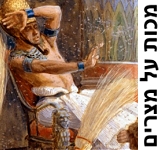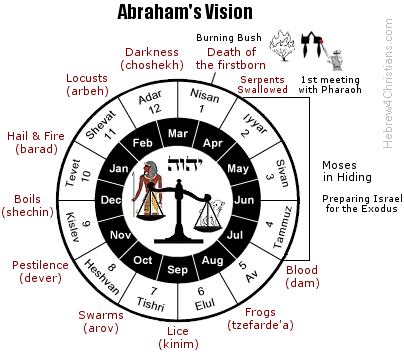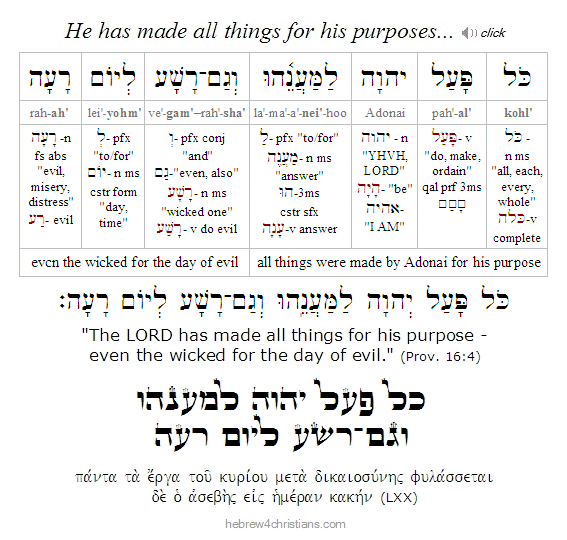|
In Parashat Bo we arrive at the successful conclusion of the LORD's campaign to free Israel from bondage in Egypt. Immediately following the description of ninth plague (i.e., the plague of darkness), redemption through the sacrifice of the Passover lamb (קָרְבָּן פֶּסַה) is explained. The Jewish people were saved by the blood of the lamb, just as today we call upon Yeshua as the Lamb of God. Notice that the word בּא ("go") and פרעה ("Pharoah") together equal the gematria of משׁיח ("mashiach"), providing a hint of the coming Messianic redemption that was foreshadowed in Egypt. Every jot and tittle, friends../
Regarding the sequence of the plagues (רֶצֶף הַמָּכּוֹת), Rabbi Bechaye (11th century, Spain) wrote that they followed one another over a twelve-month period. On Nisan 15 God spoke to Moses from the burning bush and commissioned him to go to Pharaoh. On Nisan 21, Moses told his father-in-law Yitro (Jethro) of his mission and left for Egypt. Near the end of the month of Nisan, Moses immediately went before Pharaoh and warned him to release the Jews. For the next three months (Iyyar, Sivan, and Tammuz), Moses went into hiding and instructed the elders of Israel regarding their coming deliverance. The plague of blood began on the first of Av and lasted seven days. A respite of three weeks occurred before the next plague (frogs). This was the pattern for all the ten plagues (i.e., roughly a plague a month). The last plague - that of the death of the firstborn - occurred in the month of Nisan, a year after Moses first warned Pharaoh (Exod. 4:22-23). The period of the plagues therefore totaled twelve full months, at least according to Jewish tradition (Tzenah Urenah):
- Av 1 - Blood (i.e., dam: דָם)
- Elul 1 - Frogs (i.e., tzefarde'a: צְּפַרְדֵּעַ)
- Tishri 1 - Lice (i.e., kinim: כִּנִּים)
- Cheshvan 1 - Swarms (i.e., arov: עָרוֹב)
- Kislev 1 - Pestilence (i.e., dever: דֶּבֶר)
- Tevet 1 - Boils (i.e., shechin: שְׁחִין)
- Shevat 1 - Hail and Fire (i.e., barad: בָּרָד)
- Adar 1 - Locusts (i.e., arbeh: אַרְבֶּה)
- Nisan 1 - Darkness (i.e., choshekh: חוֹשֶך)
- Nisan 15 - Death of the firstborn (i.e., makat bechorim: מַכַּת בְּכוֹרוֹת)
Here is a simplified diagram of the sequence given in the midrash:
The story of yetziat mitzraim (the Exodus from Egypt) is to be retold to every generation, and its lessons are to be applied to every age and place. Hence the Passover Seder and its focus on the needs of children. The Hebrew word for "education" is chinukh, a word that shares the same root as the word "chanukah" (חֲנֻכָּה, dedication). We "tell the story so that we may know" that the LORD is God (Exod. 10:2). Education is ultimately devotional. God called the people of Israel to cleave to Him and walk in His ways....
The first commandment given to the nation of Israel (as opposed to patriarchs or individual leaders such as Moses and Aaron) was that of Rosh Chodashim (i.e., the Biblical New Year that begins on the first new moon of Spring). "This month shall be the beginning of months for you" / הַחדֶשׁ הַזֶּה לָכֶם ראשׁ חֳדָשִׁים (Exod. 12:2). Our corporate identity therefore begins with a shared consciousness of time from a Divine perspective. The mo'edim (festivals of the LORD) all are reckoned based on the sacred calendar given to the redeemed Israelite nation. As the psalmist declared: "He made the moon for the appointed times" / עָשָׂה יָרֵחַ לְמוֹעֲדִים (Psalm 104:19). Yeshua followed this calendar, as did His first followers.
Parashat Bo begins with the LORD commanding Moses to go (bo) before Pharaoh to announce further apocalyptic judgments upon Egypt. The purpose of this power encounter was to vindicate God's justice and power (deliverance/salvation) by overthrowing the tyranny of unjust human oppression. Pharaoh's nightmare of "one little lamb" outweighing all the firstborn of Egypt was to be fulfilled.
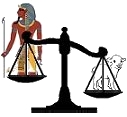
According to midrash, the plague of darkness (i.e, the last plague before the death of the firstborn) lasted six days. During the first three days, the land was dark and it was difficult to breathe. The stars were not visible. During the last three days, the darkness became "thick" and severe. If a person were sitting, he couldn't stand up, and it he were standing, he couldn't sit down. Many "Egyptianized" Israelites who did not want to escape from Egypt with their brothers also died during this plague. Why not seven days of plague, like the previous judgments? The seventh day was reserved for the time when the Egyptians pursued the Israelites at the Sea of Reeds....
Before the LORD administered the final plague - the dreaded makkat bechorot (death of the firstborn) - he instructed Moses to "please ask the Israelites to borrow from the Egyptians gold and silver..." (Exod. 11:12). According to the sages, this request was made so that God's promise made to Abraham would be fulfilled (i.e., that his descendants would escape from their bondage and afterwards come out with great possessions (Gen. 15:13-14)). According to midrash, when Moses announced the final plague, all the firstborn of Egypt gathered and demanded that the Israelites be set free. "Let the people go, for all that Moses speaks is fulfilled." The firstborn then began striking their fathers and took their jewels, silver, gold, etc. -- which they then entrusted to Moses. On the night they were killed by the plague, Moses was left with their wealth. The booty taken by the Israelites was regarded as uncollected wages for hundreds of years of forced labor.
The blood of the korban Pesach - the Passover lamb - was to be smeared on the two sides and top of the doorway, resembling the shape of the letter Chet. This letter, signifying the number 8, is connected with the word חי (chai), short for chayim (life). The blood of the lamb (דַּם הַשֶּׂה) not only saves from the judgment of death, but also is a symbol of divine life:
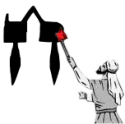
At the very moment when God "passed over" the houses of the Israelites, all the idols of the Egyptians were destroyed.
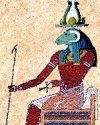
According to the Zohar, the Passover lamb was intended to demonstrate the inadequacy of the Egyptian sheep god (Khnum). The bones of the sacrificed lamb were to be left unbroken and then thrown outside. The Egyptians would then see the bones of their "god" being chewed by dogs....
The Kingdom of Heaven is assuredly not the same as the kingdom of man. Judgment is coming upon the world, just as it was in the days of Pharaoh. The day draws near. It's just a matter of time... The greater question is whether you are accounted as part of redeemed Israel or as part of the corrupt world system. May God Himself help you choose...
Hebrew Lesson
Proverbs 16:4 reading (click to listen):
|


